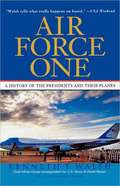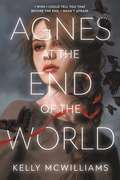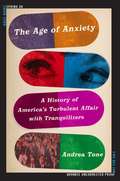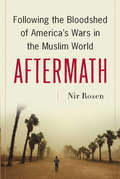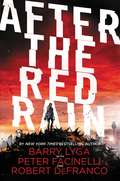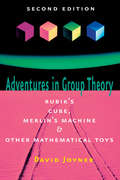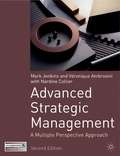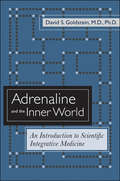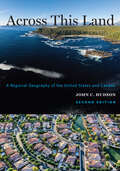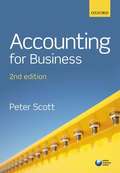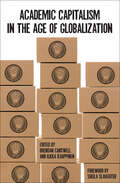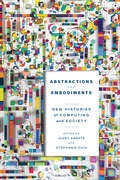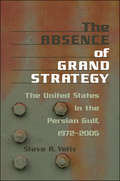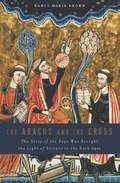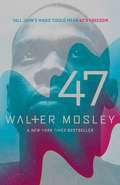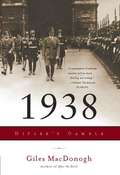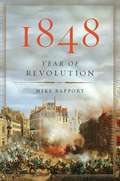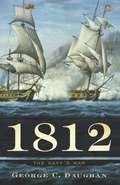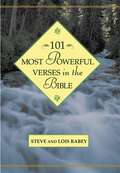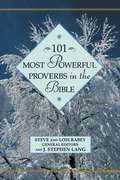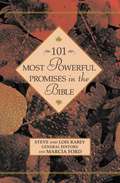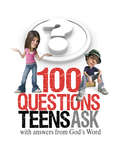- Table View
- List View
Air Force One: A History of the Presidents and Their Planes
by Kenneth T. WalshFrom the award-winning chief White House correspondent for U.S. News & World Report comes the definitive history of Air Force One. From FDR's prop-driven Pan Am to the glimmering blue and white jumbo 747 on which George W. Bush travels, the president's plane has captured the public's awe and imagination, and is recognized around the world as a symbol of American power. In this unique book, Kenneth Walsh looks at the decisions that our last 12 presidents made on the plane; the personality traits and peccadilloes they revealed when their guard was down; and the way they each established a distinctive mood aboard that was a reflection of their times, as well as their individual personalities. Based on interviews with four living presidents, scores of past and present White House officials, and staff and crew members of Air Force One, Walsh's book reveals countless fascinating stories of life aboard the "flying White House." It also features descriptions of the food, the decor, the bedrooms, the medical clinic, and much more--as well as remarkable photos of the planes (inside and out) and the presidents.
Agnes at the End of the World
by Kelly McWilliamsThe Handmaid's Tale meets Wilder Girls in this genre-defying novel about a girl who escapes a terrifying cult only to discover that the world Outside has succumbed to a viral apocalypse.Agnes loves her home of Red Creek -- its quiet, sunny mornings, its dusty roads, and its God. There, she cares tirelessly for her younger siblings and follows the town's strict laws. What she doesn't know is that Red Creek is a cult, controlled by a madman who calls himself a prophet.Then Agnes meets Danny, an Outsider boy, and begins to question what is and isn't a sin. Her younger brother, Ezekiel, will die without the insulin she barters for once a month, even though medicine is considered outlawed. Is she a sinner for saving him? Is her sister, Beth, a sinner for dreaming of the world beyond Red Creek?As the Prophet grows more dangerous, Agnes realizes she must escape with Ezekiel and leave everyone else, including Beth, behind. But it isn't safe Outside, either: A viral pandemic is burning through the population at a terrifying rate. As Agnes ventures forth, a mysterious connection grows between her and the Virus. But in a world where faith, miracles, and cruelty have long been indistinguishable, will Agnes be able to choose between saving her family and saving the world? p.p1 {margin: 0.0px 0.0px 0.0px 0.0px; font: 13.0px Times} p.p2 {margin: 0.0px 0.0px 0.0px 0.0px; font: 13.0px Times; min-height: 16.0px}
The Age of Anxiety: A History of America's Turbulent Affair with Tranquilizers
by Andrea ToneAnxious Americans have increasingly pursued peace of mind through pills and prescriptions. In 2006, the National Institute of Mental Health estimated that 40 million adult Americans suffer from an anxiety disorder in any given year: more than double the number thought to have such a disorder in 2001. Anti-anxiety drugs are a billion-dollar business. Yet as recently as 1955, when the first tranquilizer-Miltown-went on the market, pharmaceutical executives worried that there wouldn't be interest in anxiety-relief. At mid-century, talk therapy remained the treatment of choice. But Miltown became a sensation-the first psychotropic blockbuster in United States history. By 1957, Americans had filled 36 million prescriptions. Patients seeking made-to-order tranquility emptied drugstores, forcing pharmacists to post signs reading "more Miltown tomorrow.” The drug's financial success and cultural impact revolutionized perceptions of anxiety and its treatment, inspiring the development of other lifestyle drugs including Valium and Prozac. In The Age of Anxiety, Andrea Tone draws on a broad array of original sources-manufacturers' files, FDA reports, letters, government investigations, and interviews with inventors, physicians, patients, and activists-to provide the first comprehensive account of the rise of America's tranquilizer culture. She transports readers from the bomb shelters of the Cold War to the scientific optimism of the Baby Boomers, to the "just say no” Puritanism of the late 1970s and 1980s. A vibrant history of America's long and turbulent affair with tranquilizers, The Age of Anxiety casts new light on what it has meant to seek synthetic solutions to everyday angst.
Aftermath: Following the Bloodshed of America's Wars in the Muslim World
by Nir RosenNir Rosen&’s Aftermath, an extraordinary feat of reporting, follows the contagious spread of radicalism and sectarian violence that the U.S. invasion of Iraq and the ensuing civil war have unleashed in the Muslim world. Rosen—who the Weekly Standard once bitterly complained has &“great access to the Baathists and jihadists who make up the Iraqi insurgency&”— has spent nearly a decade among warriors and militants who have been challenging American power in the Muslim world. In Aftermath, he tells their story, showing the other side of the U.S. war on terror, traveling from the battle-scarred streets of Baghdad to the alleys, villages, refugee camps, mosques, and killing grounds of Jordan, Syria, Egypt, Lebanon, and finally Afghanistan, where Rosen has a terrifying encounter with the Taliban as their &“guest,&” and witnesses the new Obama surge fizzling in southern Afghanistan.Rosen was one of the few Westerners to venture inside the mosques of Baghdad to witness the first stirrings of sectarian hatred in the months after the U.S. invasion. He shows how weapons, tactics, and sectarian ideas from the civil war in Iraq penetrated neighboring countries and threatened their stability, especially Lebanon and Jordan, where new jihadist groups mushroomed. Moreover, he shows that the spread of violence at the street level is often the consequence of specific policies hatched in Washington, D.C. Rosen offers a seminal and provocative account of the surge, told from the perspective of U.S. troops on the ground, the Iraqi security forces, Shiite militias and Sunni insurgents that were both allies and adversaries. He also tells the story of what happened to these militias once they outlived their usefulness to the Americans.Aftermath is both a unique personal history and an unsparing account of what America has wrought in Iraq and the region. The result is a hair- raising, 360-degree view of the modern battlefield its consequent humanitarian catastrophe, and the reality of counterinsurgency.
After the Red Rain
by Barry Lyga Peter Facinelli Robert DeFrancoA post apocalyptic novel with a cinematic twist from New York Times bestseller Barry Lyga, actor Peter Facinelli, and producer Robert DeFranco. On the ruined planet Earth, where 50 billion people are confined to megacities and resources are scarce, Deedra has been handed a bleak and mundane existence by the Magistrate she works so hard for. But one day she comes across a beautiful boy named Rose struggling to cross the river--a boy with a secretive past and special abilities, who is somehow able to find comfort and life from their dying planet. But just as the two form a bond, it is quickly torn apart after the Magistrate's son is murdered and Rose becomes the prime suspect. Little do Deedra and Rose know how much their relationship will affect the fate of everyone who lives on the planet.
Adventures in Group Theory: Rubik's Cube, Merlin's Machine, and Other Mathematical Toys
by David JoynerThis updated and revised edition of David Joyner’s entertaining "hands-on" tour of group theory and abstract algebra brings life, levity, and practicality to the topics through mathematical toys.Joyner uses permutation puzzles such as the Rubik’s Cube and its variants, the 15 puzzle, the Rainbow Masterball, Merlin’s Machine, the Pyraminx, and the Skewb to explain the basics of introductory algebra and group theory. Subjects covered include the Cayley graphs, symmetries, isomorphisms, wreath products, free groups, and finite fields of group theory, as well as algebraic matrices, combinatorics, and permutations.Featuring strategies for solving the puzzles and computations illustrated using the SAGE open-source computer algebra system, the second edition of Adventures in Group Theory is perfect for mathematics enthusiasts and for use as a supplementary textbook.
Advanced Strategic Management: A Multi-perspective Approach (2nd edition) (PDF)
by Mark Jenkins Veronique Ambrosini Nardine CollierThis text pulls together a broad range of contrasting perspectives on strategy in a form that can be used for advanced undergraduate and MBA-level teaching. Building on prior knowledge of strategic decision making, it complements general strategy texts by providing an umbrella view of the multi-dimensional nature of strategic management. Featuring expert contributions, the discussion of each perspective is enhanced by the extensive use of empirical case examples. Alternate ISBN 9781137377944
Adrenaline and the Inner World: An Introduction to Scientific Integrative Medicine
by David S. GoldsteinThis accessible work is the first in more than seventy-five years to discuss the many roles of adrenaline in regulating the "inner world" of the body. David S. Goldstein, an international authority and award-winning teacher, introduces new concepts concerning the nature of stress and distress across the body's regulatory systems. Discussing how the body's stress systems are coordinated, and how stress, by means of adrenaline, may affect the development, manifestations, and outcomes of chronic diseases, Goldstein challenges researchers and clinicians to use scientific integrative medicine to develop new ways to treat, prevent, and palliate disease. Goldstein explains why a former attorney general with Parkinson disease has a tendency to faint, why young astronauts in excellent physical shape cannot stand up when reexposed to Earth's gravity, why professional football players can collapse and die of heat shock during summer training camp, and why baseball players spit so much. Adrenaline and the Inner World is designed to supplement academic coursework in psychology, psychiatry, endocrinology, cardiology, complementary and alternative medicine, physiology, and biochemistry. It includes an extensive glossary.
Across This Land: A Regional Geography of the United States and Canada (Creating the North American Landscape)
by John HudsonBased on decades of research and written in clear, concise prose by one of the foremost geographers in North America, John C. Hudson's Across This Land is a comprehensive regional geography of the North American continent. Dividing the terrain into ten regions, which are then subdivided into twenty-seven smaller areas, Hudson's brisk narrative reveals the dynamic processes of each area's distinctive place-specific characteristics. Focusing on how human activities have shaped and have been shaped by the natural environment, Hudson considers physical, political, and historical geography. He also highlights related topics, including resource exploitation, economic development, and population change. Praised in its first edition as a readable and reliable interpretation of United States and Canadian geography, the revised Across This Land retains these strengths while adding substantial new material. Incorporating the latest available population and economic data, this thoroughly updated edition includes• reflections on new developments, such as resource schemes, Native governments in Atlantic Canada, and the role of climate change in the Arctic• a new section focused on the US Pacific insular territories west of Hawaii• evolving views of oil and gas production resulting from the introduction of hydraulic fracturing• revised text and maps involving agricultural production based on the 2017 Census of Agriculture• current place names• more than 130 photographsThe most extensive regional geography of the North American continent on the market, Hudson's Across This Land will continue as the standard text in geography courses dealing with Canada and the United States, as well as a popular reference work for scholars, students, and lay readers.
Across This Land: A Regional Geography of the United States and Canada (Creating the North American Landscape)
by John HudsonBased on decades of research and written in clear, concise prose by one of the foremost geographers in North America, John C. Hudson's Across This Land is a comprehensive regional geography of the North American continent. Dividing the terrain into ten regions, which are then subdivided into twenty-seven smaller areas, Hudson's brisk narrative reveals the dynamic processes of each area's distinctive place-specific characteristics. Focusing on how human activities have shaped and have been shaped by the natural environment, Hudson considers physical, political, and historical geography. He also highlights related topics, including resource exploitation, economic development, and population change. Praised in its first edition as a readable and reliable interpretation of United States and Canadian geography, the revised Across This Land retains these strengths while adding substantial new material. Incorporating the latest available population and economic data, this thoroughly updated edition includes• reflections on new developments, such as resource schemes, Native governments in Atlantic Canada, and the role of climate change in the Arctic• a new section focused on the US Pacific insular territories west of Hawaii• evolving views of oil and gas production resulting from the introduction of hydraulic fracturing• revised text and maps involving agricultural production based on the 2017 Census of Agriculture• current place names• more than 130 photographsThe most extensive regional geography of the North American continent on the market, Hudson's Across This Land will continue as the standard text in geography courses dealing with Canada and the United States, as well as a popular reference work for scholars, students, and lay readers.
Accounting For Business (Second Edition) (PDF)
by Peter ScottThis textbook is a refreshingly clear introduction to the core accounting topics that non-specialist students need to master. Designed to help students learn key principles, reinforce understanding, and apply accounting concepts to real business decisions, it is an ideal first stepping stoneinto the world of accounting. Peter Scott's Accounting for Business:* Firmly sets accounting principles in context by using newspaper articles and online media to help students understand the relevance of accounting to a variety of business professions* A range of Financial and Management Accounting examples recur throughout the book so students can strengthen their understanding of the material covered as the author regularly reviews and recaps information. Its unique online workbook includes the following features for students:* Interactive Multiple Choice Questions for revising key topics* Numerical exercises to help you practise the calculation of accounting information from given sets of data* 'Go back over this again' feature containing a mix of further examples, written exercises, true or false questions and annotated accounting information to help you revise and revisit concepts you may be unsure of* Narrated video presentations provide practical demonstrations of how more complex accounting tasks are dealt with* Web links directing you towards primary source material and articles from which you can learn more about the companies and organizations covered in the bookThe second edition is also available with Dashboard, a brand new online learning and assessment tool. Dashboard provides lecturers with a complete solution to teaching accounting, featuring:* Quizzes. A test bank of over 500 ready-to-use questions, tailored specifically to Accounting for Business. Gives you the flexibility you need to manage, set and develop quizzes that are tailored perfectly to your course. * Gradebook. Automatically grades student responses to quizzes, while its visual heat maps provide at-a-glance information about student achievement and engagement. * Course content. Additional material to support your teaching, including PowerPoint slides and additional examples and solutions. * Communication. Share course news, spark a class discussion, or email your students with course information, all through the communication tab.
Academic Capitalism in the Age of Globalization
by Sheila Slaughter Brendan Cantwell Ilkka KauppinenToday, nearly every aspect of higher educationâ€�including student recruitment, classroom instruction, faculty research, administrative governance, and the control of intellectual propertyâ€�is embedded in a political economy with links to the market and the state. Academic capitalism offers a powerful framework for understanding this relationship. Essentially, it allows us to understand higher education’s shift from creating scholarship and learning as a public good to generating knowledge as a commodity to be monetized in market activities. In Academic Capitalism in the Age of Globalization, Brendan Cantwell and Ilkka Kauppinen assemble an international team of leading scholars to explore the profound ways in which globalization and the knowledge economy have transformed higher education around the world. The book offers an in-depth assessment of the theoretical foundations of academic capitalism, as well as new empirical insights into how the process of academic capitalism has played out. Chapters address academic capitalism from historical, transnational, national, and local perspectives. Each contributor offers fascinating insights into both new conceptual interpretations of and practical institutional and national responses to academic capitalism.Incorporating years of research by influential theorists and building on the work of Sheila Slaughter, Larry Leslie, and Gary Rhoades, Academic Capitalism in the Age of Globalization provides a provocative update for understanding academic capitalism. The book will appeal to anyone trying to make sense of contemporary higher education.
Abstractions and Embodiments: New Histories of Computing and Society (Studies in Computing and Culture)
by Janet Abbate Stephanie DickCutting-edge historians explore ideas, communities, and technologies around modern computing to explore how computers mediate social relations.Computers have been framed both as a mirror for the human mind and as an irreducible other that humanness is defined against, depending on different historical definitions of "humanness." They can serve both liberation and control because some people's freedom has historically been predicated on controlling others. Historians of computing return again and again to these contradictions, as they often reveal deeper structures.Using twin frameworks of abstraction and embodiment, a reformulation of the old mind-body dichotomy, this anthology examines how social relations are enacted in and through computing. The authors examining "Abstraction" revisit central concepts in computing, including "algorithm," "program," "clone," and "risk." In doing so, they demonstrate how the meanings of these terms reflect power relations and social identities. The section on "Embodiments" focuses on sensory aspects of using computers as well as the ways in which gender, race, and other identities have shaped the opportunities and embodied experiences of computer workers and users. Offering a rich and diverse set of studies in new areas, the book explores such disparate themes as disability, the influence of the punk movement, working mothers as technical innovators, and gaming behind the Iron Curtain. Abstractions and Embodiments reimagines computing history by questioning canonical interpretations, foregrounding new actors and contexts, and highlighting neglected aspects of computing as an embodied experience. It makes the profound case that both technology and the body are culturally shaped and that there can be no clear distinction between social, intellectual, and technical aspects of computing. Contributors: Janet Abbate, Marc Aidinoff, Troy Kaighin Astarte, Ekaterina Babinsteva, André Brock, Maarten Bullynck, Jiahui Chan, Gerardo Con Diaz, Liesbeth De Mol, Stephanie Dick, Kelcey Gibbons, Elyse Graham, Michael J. Halvorson, Mar Hicks, Scott Kushner, Xiaochang Li, Zachary Loeb, Lisa Nakamura, Tiffany Nichols, Laine Nooney, Elizabeth Petrick, Cierra Robson, Hallam Stevens, Jaroslav Švelch
Abstractions and Embodiments: New Histories of Computing and Society (Studies in Computing and Culture)
by Janet Abbate and Stephanie DickCutting-edge historians explore ideas, communities, and technologies around modern computing to explore how computers mediate social relations.Computers have been framed both as a mirror for the human mind and as an irreducible other that humanness is defined against, depending on different historical definitions of "humanness." They can serve both liberation and control because some people's freedom has historically been predicated on controlling others. Historians of computing return again and again to these contradictions, as they often reveal deeper structures.Using twin frameworks of abstraction and embodiment, a reformulation of the old mind-body dichotomy, this anthology examines how social relations are enacted in and through computing. The authors examining "Abstraction" revisit central concepts in computing, including "algorithm," "program," "clone," and "risk." In doing so, they demonstrate how the meanings of these terms reflect power relations and social identities. The section on "Embodiments" focuses on sensory aspects of using computers as well as the ways in which gender, race, and other identities have shaped the opportunities and embodied experiences of computer workers and users. Offering a rich and diverse set of studies in new areas, the book explores such disparate themes as disability, the influence of the punk movement, working mothers as technical innovators, and gaming behind the Iron Curtain. Abstractions and Embodiments reimagines computing history by questioning canonical interpretations, foregrounding new actors and contexts, and highlighting neglected aspects of computing as an embodied experience. It makes the profound case that both technology and the body are culturally shaped and that there can be no clear distinction between social, intellectual, and technical aspects of computing. Contributors: Janet Abbate, Marc Aidinoff, Troy Kaighin Astarte, Ekaterina Babinsteva, André Brock, Maarten Bullynck, Jiahui Chan, Gerardo Con Diaz, Liesbeth De Mol, Stephanie Dick, Kelcey Gibbons, Elyse Graham, Michael J. Halvorson, Mar Hicks, Scott Kushner, Xiaochang Li, Zachary Loeb, Lisa Nakamura, Tiffany Nichols, Laine Nooney, Elizabeth Petrick, Cierra Robson, Hallam Stevens, Jaroslav Švelch
The Absence of Grand Strategy: The United States in the Persian Gulf, 1972–2005
by Steve A. YetivGreat powers and grand strategies. It is easy to assume that the most powerful nations pursue and employ consistent, cohesive, and decisive policies in trying to promote their interests in regions of the world. Popular theory emphasizes two such grand strategies that great powers may pursue: balance of power policy or hegemonic domination. But, as Steve A. Yetiv contends, things may not always be that cut and dried. Analyzing the evolution of the United States' foreign policy in the Persian Gulf from 1972 to 2005, Yetiv offers a provocative and panoramic view of American strategies in a region critical to the functioning of the entire global economy. Ten cases—from the policies of the Nixon administration to George W. Bush's war in Iraq—reveal shifting, improvised, and reactive policies that were responses to unanticipated and unpredictable events and threats. In fact, the distinguishing feature of the U.S. experience in the Gulf has been the absence of grand strategy.Yetiv introduces the concept of "reactive engagement" as an alternative approach to understanding the behavior of great powers in unstable regions. At a time when the effects of U.S. foreign policy are rippling across the globe, The Absence of Grand Strategy offers key insight into the nature and evolution of American foreign policy in the Gulf.
The Abacus and the Cross: The Story of the Pope Who Brought the Light of Science to the Dark Ages
by Nancy Marie BrownThe medieval Catholic Church, widely considered a source of intolerance and inquisitorial fervor, was not anti-science during the Dark Ages-in fact, the pope in the year 1000 was the leading mathematician and astronomer of his day. Called "The Scientist Pope,” Gerbert of Aurillac rose from peasant beginnings to lead the church. By turns a teacher, traitor, kingmaker, and visionary, Gerbert is the first Christian known to teach math using the nine Arabic numerals and zero.In The Abacus and the Cross, Nancy Marie Brown skillfully explores the new learning Gerbert brought to Europe. A fascinating narrative of one remarkable math teacher, The Abacus and the Cross will captivate readers of history, science, and religion alike.
47
by Walter MosleyNew York Times Bestseller"Engaging." --Publishers Weekly, starred reviewMaster storyteller Walter Mosley deftly mixes speculative and historical fiction in this daring New York Times bestselling novel, reminiscent of Colson Whitehead's The Underground Railroad.47 is a young slave boy living under the watchful eye of a brutal slave master. His life seems doomed until he meets a mysterious runaway slave, Tall John. 47 finds himself swept up in a struggle for his own liberation.
1938: Hitler's Gamble
by Giles MacDonoghIn this masterful narrative, acclaimed historian Giles MacDonogh chronicles Adolf Hitler's consolidation of power over the course of one year. Until 1938, Hitler could be dismissed as a ruthless but efficient dictator, a problem to Germany alone; after 1938 he was clearly a threat to the entire world.It was in 1938 that Third Reich came of age. The Führer brought Germany into line with Nazi ideology and revealed his plans to take back those parts of Europe lost to "Greater Germany” after the First World War. From the purging of the army in January through the Anschluss in March, from the Munich Conference in September to the ravages of Kristallnacht in November, MacDonogh offers a gripping account of the year Adolf Hitler came into his own and set the world inexorably on track to a cataclysmic war.
1848: Year of Revolution
by Mike RapportA "lively, panoramic" history of a revolutionary year (New York Times) In 1848, a violent storm of revolutions ripped through Europe. The torrent all but swept away the conservative order that had kept peace on the continent since Napoleon's defeat at Waterloo in 1815 -- but which in many countries had also suppressed dreams of national freedom. Political events so dramatic had not been seen in Europe since the French Revolution, and they would not be witnessed again until 1989, with the revolutions in Eastern and Central Europe. In 1848, historian Mike Rapport examines the roots of the ferment and then, with breathtaking pace, chronicles the explosive spread of violence across Europe. A vivid narrative of a complex chain of interconnected revolutions, 1848 tells the exhilarating story of Europe's violent "Spring of Nations" and traces its reverberations to the present day.
1812: The Navy's War
by George C. DaughanAt the outbreak of the War of 1812, America's prospects looked dismal. It was clear that the primary battlefield would be the open ocean-but America's war fleet, only twenty ships strong, faced a practiced British navy of more than a thousand men-of-war. Still, through a combination of nautical deftness and sheer bravado, the American navy managed to take the fight to the British and turn the tide of the war: on the Great Lakes, in the Atlantic, and even in the eastern Pacific. In 1812: The Navy's War, prizewinning historian George C. Daughan tells the thrilling story of how a handful of heroic captains and their stalwart crews overcame spectacular odds to lead the country to victory against the world's greatest imperial power. A stunning contribution to military and national history, 1812: The Navy's War is the first complete account in more than a century of how the U.S. Navy rescued the fledgling nation and secured America's future.
1812: The Navy's War
by George C DaughanAt the outbreak of the War of 1812, America's prospects looked dismal. It was clear that the primary battlefield would be the open ocean -- but America's war fleet, only twenty ships strong, faced a practiced British navy of more than a thousand men-of-war. Still, through a combination of nautical deftness and sheer bravado, the American navy managed to take the fight to the British and turn the tide of the war: on the Great Lakes, in the Atlantic, and even in the eastern Pacific. In 1812: The Navy's War, prizewinning historian George C. Daughan tells the thrilling story of how a handful of heroic captains and their stalwart crews overcame spectacular odds to lead the country to victory against the world's greatest imperial power. A stunning contribution to military and national history, 1812: The Navy's War is the first complete account in more than a century of how the U.S. Navy rescued the fledgling nation and secured America's future.
101 Most Powerful Verses in the Bible
by Lois Rabey Steven RabeyThrough an examination of the Bible's most powerful verses, the newest installment in the 101 Most Powerful series reminds us that we are not alone in this world. In the Old Testament, God spoke through patriarchs, poets, and prophets. In the new Testament, he reaches out through Christ and Christ's disciples. Highlighting some of the key verses of the Bible, Steve and Lois Rabey demonstrate how God constantly communicates his will and his love to his children.
101 Most Powerful Proverbs in the Bible
by J. Stephen Lang Steven Rabey Lois Rabey General Editors101 MOST POWERFUL PROVERBS IN THE BIBLE takes the best of the proverbs and details them for us. Filled with illustrations of daily life, it seeks to remind us of what's truly important--living wisely, kindly, and well.
101 Most Powerful Promises in the Bible
by Steven Rabey Lois Rabey General Editors Marcia FordFor anyone who is searching for guidance in a time of need, finds that their faith is floundering, or simply wants to infuse some inspiration into their day, 101 MOST POWERFUL PROMISES IN THE BIBLE will provide the strength of God's message at the turn of a page.
100 Questions Teens Ask with answers from God's Word
by Freeman SmithTeens have questions and lots of them. This book guides Teens to the source of wisdom, the Bible for their answers to 100 of the most often asked questions. It addresses topics of importance for young adults that will help them build their faith. It's reassuring answers will not only help the teen who reads them, but will also give them answers to share with their friends and peers.
